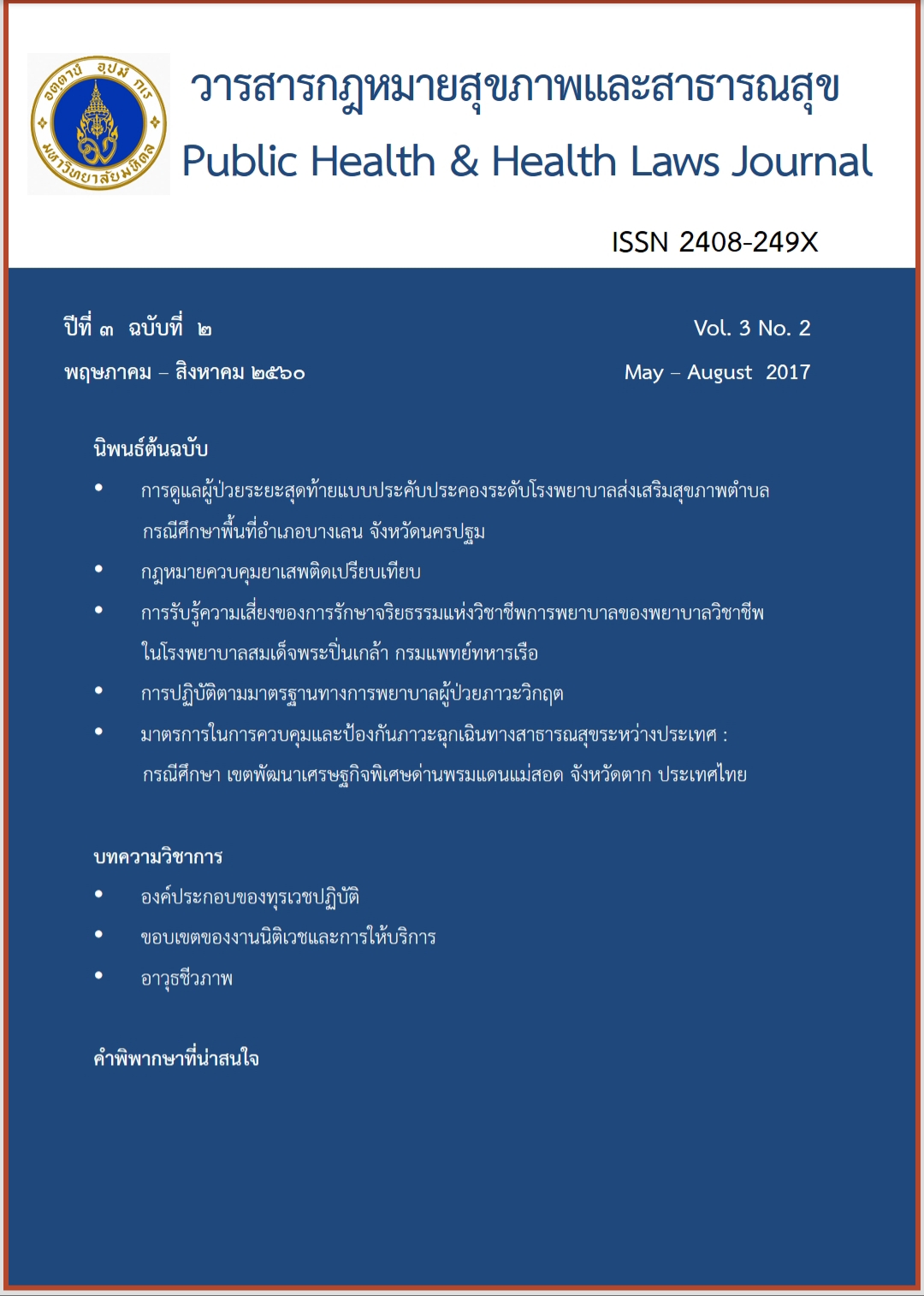Biological Weapon
Keywords:
Biological weapon, Biological Weapons Convention, Biological agentsAbstract
This article aims to study the evolution and adoption of biological agents used in the cause of war or terrorism in the form of a biological weapon which causes impact and serious damage to the living thing and the environment. Together with the study of the global community together to eliminate biological weapons capable of mass destruction in the form of Biological Weapons Convention or BWC Convention
The study indicated that the use of biological weapons in a war that has existed since ancient times, the history has recorded that the beginning of the year 1346 A.D and have been developed up until now. The country's efforts to control the use of these biological weapons to jointly prepared by Biological Weapons Convention and on their destruction effective from 26th March 1975. However, Biological Weapons Convention has drawbacks in the scope of the Convention itself and the lack of a monitoring system under the Convention. Some countries have also exploits a gap in breach of its obligations, including some countries that do not agree with strict monitoring because they believe it will cause more harm than good especially in industry.
However, the most important in reducing or preventing the spread of biological weapons is understanding and mutual trust between countries to live together without war and peace.
References
กระทรวงการต่างประเทศ. (2553). การลดอาวุธที่มีอานุภาพทำลายล้างสูง. 28 สิงหาคม 2558. Available at http:// www.mfa.go.th/main/th/issues/9901
จุฑารัตน์ ถาวรนันท์. (2545). การป้องกันภัยจากอาวุธชีวภาพ. 28 สิงหาคม 2558. Available at http://www.webdb. dmsc.moph.go.th/ifc_nih/a_nih_3_002c.asp?info_id=616
จุรีภรณ์ บุณยวงศ์วิโรจน์. (2552). การก่อการร้ายทางชีวภาพ ศึกษาเฉพาะกรณี: การควบคุมเชื้อโรค และสารพิษ. กรุงเทพฯ: วิทยาลัยการยุติธรรม สำนักงานศาลยุติธรรม.
ฉัตรวดี จินดาวงษ์. (2544). อาเซียนกับการเป็นเขตปลอด WMD. ASEAN Highlights 2011: 32-35.
บุญเรือง คำศรี. (2555). อาวุธชีวภาพและการก่อการร้ายทางชีวภาพ. วารสารนิติเวชศาสตร์ 4(3): 259-290.
ประเสริฐ ทองเจริญ. (2546). มหันตภัยอาวุธชีวภาพและอาวุธเคมี. กรุงเทพฯ: บริษัทวิทยพัฒน์จำกัด.
พงษธร เศรษฐถาวร. (2549). กฎหมายระหว่างประเทศว่าด้วยการควบคุมอาวุธชีวภาพ. รพี 49: 181-193.
ศักดิ์สิน รัศมิทัต. (2546). สงครามอาวุธเคมี อาวุธชีวภาพ. กรุงเทพฯ: บริษัท สร้างสรรค์บุ๊ก จำกัด.
ศุภรา. (2549). อาวุธเชื้อโรคในไทย...เรื่องจริงหรือแค่ความกังวล. ชีวจิต, 44-46.
สำนักงานพัฒนาวิทยาศาสตร์และเทคโนโลยีแห่งชาติ กระทรวงวิทยาศาสตร์เทคโนโลยีและ สิ่งแวดล้อม. (2544). การสัมมนาเรื่อง “อนุสัญญาห้ามอาวุธชีวภาพกับประเทศไทย”, 3 เมษายน 2544 ณ โรงแรมเซ็นจูรี่พาร์ค กรุงเทพฯ. ปทุมธานี: ศูนย์ความหลากหลายทางชีวภาพ.
อภิชาต พิกุลทอง. (2550). ความสำคัญของสารชีวภาพเพื่อการเกษตร. 5 ตุลาคม 2558. Available at http://www. gotoknow.org/posts/153221
Ambassador Paul van den Ijssel. (2011). President’s Message.Retrieved October 28, 2015, from the Biological and Toxin Weapons Convention Available at http://www.opbw.org
Office of Export Control Cooperation. (2011). Overview of U.S. Export Control System, Retrieved October 28, 2015, Available at v http://www.state.gov/strategictrade/overview/index. htm
Downloads
Published
How to Cite
Issue
Section
License
Disclaimer and Copyright Notice
The content and information presented in articles published in the Journal of Law and Public Health Policy represent the opinions and sole responsibility of the respective authors. The editorial board does not necessarily agree with or assume any responsibility for the views expressed.
All articles, data, content, images, and other materials published in the Journal of Law and Public Health Policy are the intellectual property of the journal. Any individual or organization wishing to reproduce, distribute, or otherwise use the entirety or any part of such materials must provide proper citation.





